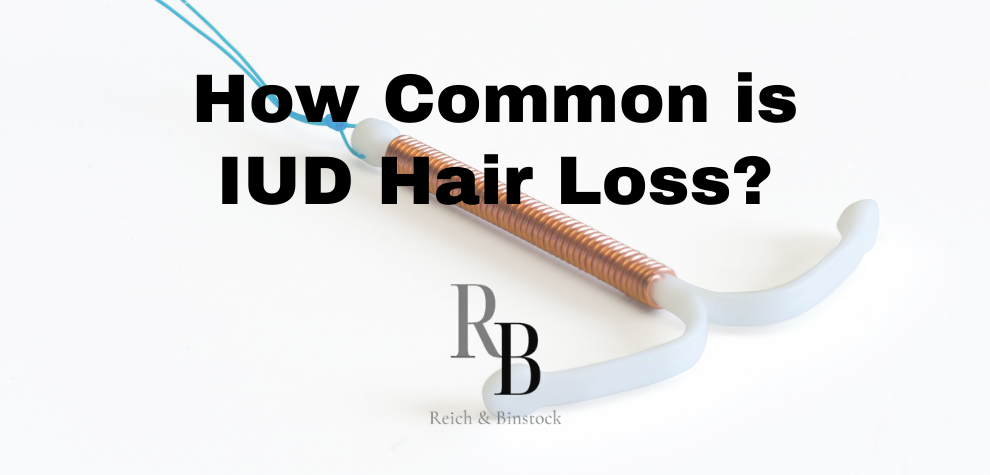Every form of birth control comes with its own set of side effects and risks. But with IUD use on the rise in the United States, more and more women are experiencing IUD hair loss among other uncomfortable side effects. If your IUD causes significant, irreversible damage to your health or fertility, defective medical device attorneys at Reich & Binstock want to make sure you receive the compensation you deserve. Call our office today at 713-622-7271 to see if you have a case.
Different Types of IUDs
The FDA has approved five different types of IUDs for use in the United States. They are:
- Paragard
- Mirena
- Kyleena
- Liletta
- Skyla
These five types of IUDs are separated into two different types: copper and hormonal IUDs. Paragard is the only copper IUD that’s safe for use in the United States. The other four are hormonal IUDs.
How Do IUDs Work?
Copper and hormonal IUDs work differently. The Paragard IUD is wrapped in copper which basically repels sperm so that they’re unable to reach an egg. The other four types of IUDs use the progestin hormone to do these two things:
- Making cervical mucus thicker which traps sperm, preventing them from reaching an egg.
- Progestin can stop ovulation. If there’s no egg for sperm to fertilize, then there won’t be a pregnancy.
IUDs are one of the most effective types of long term birth control on the market. It has a success rate of over 99.9% and it can last between 3 to 12 years. But if a woman were to decide that they wanted to have children, their doctor could easily remove it. Women could then get pregnant almost immediately after removal.
How Many Women Use IUDs?
Of the 65% of American women (between the ages of 15 and 49) who are actively using some kind of birth control, about 14% of women use IUDs according to CDC data.
How Many Women Use Other Types of Birth Control?
The most common type of birth control among American women is sterilization, with 18.6% choosing this method according to the CDC. 12.6% of women use the pill, 10.3% use long-acting reversible contraceptives (like implants and injections), and 8.7% use male condoms.
Why Do IUDs Cause Hair Loss?
Hormonal IUDs are more likely to cause hair loss than the copper IUD. Doctors and researchers believe that low estrogen levels can cause hair loss possibly due to the progestin hormone in some IUDs. In fact, hair growth and texture is often boiled down to sex hormones, which is why many women experience hair texture changes during pregnancy. Sex hormones are also the culprit for all that body hair growth during puberty.
How Common is Hair Loss with IUD?
Mirena’s product label states that IUD hair loss happens in less than 5% of women. In a Kyleena clinical study, approximately 1% of women experienced hair loss. As for Liletta and Skyla, there’s very little data available for hair loss. However, it’s still listed as a rare side effect on the product labels. Paragard is less likely to cause hair loss compared to the other IUDs, but it’s still a possible and rare side effect.
What Other Conditions Could Cause Hair Loss?
Your IUD may not be causing hair loss. Instead, a plethora of other conditions could be causing this issue. Before making assumptions, it’s important to see a doctor and inspect your overall health for any other potential hair loss culprits.
The most common causes of hair loss include:
- Hypothyroidism or hyperthyroidism
- Aging
- General malnutrition, specifically vitamin A, C, D, E deficiencies. Iron, biotin, zinc, and protein deficiencies can also cause hair loss.
- Long term, chronic stress
- Chemotherapy
- Some blood thinners
- Some antidepressants
- Pregnancy
- Menopause
- Rapid weight loss
- Specific hair treatments such as coloring, bleaching, perming, straightening, and curling.
Can I Reverse IUD Hair Loss?
Any negative IUD-related side effects, including hair loss, will likely stop once a doctor removes your IUD. In fact, two out of three women involved in a New Zealand study who removed their IUDs due to hair loss have completely regrown their hair. But it’s important to mention that hair growth is slow. So if you don’t see progress right away, there are a few things you can do to potentially speed up hair growth.
- Eat a nutritious diet with plenty of fruits, vegetables, and protein
- Take a multivitamin that will treat any vitamin deficiencies that may be contributing to hair loss
- Avoid overtreating your hair with heat, bleach, and color
- Wash your hair every two to three days because over washing dries out the hair, making it dry, brittle, and prone to breaking
How to Prevent IUD Hair Loss
If you’re looking to prevent IUD hair loss without removing the device, you should definitely make an appointment with your doctor. They will first run some tests to determine if there is another underlying cause of your hair loss. If they determine that your IUD is the most likely cause, they may suggest a diet change, various vitamins, or Minoxidil 2%.
Minoxidil 2%
If diet and vitamin supplements don’t slow down or stop your IUD hair loss, ask your doctor about Minoxidil 2%. This drug is the only FDA approved, over-the-counter hair loss treatment in the U.S. for women. Minoxidil 2% works by lengthening the growth phase of the hair follicles. Most women find that it either stops IUD hair loss or promotes hair growth.
Common IUD Side Effects Immediately After Insertion
If you’re thinking of getting an IUD, it’s important to know exactly what to expect in the 24 to 48 hours after your doctor inserts the device.
After a doctor inserts an IUD, women may experience:
- Intense pain
- Spotting or bleeding
- Dizziness
- Cramping
- Back aches
- Nausea or vomiting
- Sweating
- Fainting
Women can also experienced a change in periods in the first three to six months after IUD insertion, whether that be irregularity or heavier bleeding. Those who have IUDs should be aware of the side effects association with an IUD that is out of place or signs of IUD perforation.
Other Common IUD Side Effects
The side effects you may experience will depend on your hormones, your preexisting conditions, and the type of IUD you choose.
Kyleena
As stated previously, Kyleena is one of the few hormonal IUDs that women can choose from. Common side effects associated with Kyleena include:
- Vulvovaginitis, which is inflammation on the outside of the vagina
- Cramping and general pelvic pain
- Headaches
- Painful periods
- Breast soreness
- Ovarian cysts which occur in 22% of women who use Kyleena
- Acne
Mirena
As another type of hormonal IUD, Mirena can cause these side effects:
- Ovarian cysts which occur in 12% of women who use Mirena
- Missed periods which happens to approximately two out of 10 women after one year of using Mirena
- Cramping and general pelvic pain
- Vulvovaginitis
- Headaches
- Changes in vaginal discharge
- Spotting
- High blood pressure
A lengthy list of compensable Mirena injuries exists. If you’ve experienced any of these, we recommend speaking with an experienced birth control defects lawyer immediately.
Skyla
As another type of hormonal IUD, Skyla can cause these side effects:
- Missed periods which happens to approximately one out of 16 women after one year of using Skyla
- Painful periods
- Ovarian cysts which happen to approximately 14% of women who use Skyla
- Spotting
- Acne
- Headaches
- Vulvovaginitis
Liletta
As another type of hormonal IUD, Liletta can cause these side effects:
- Irregular periods and spotting for the first three to six months
- Ovarian cysts
- Headaches
- Breast soreness
- Weight gain
- Nausea
- Spotting
Paragard
As the only non-hormonal IUD approved for use in the U.S., Paragard can cause these side effects:
- Allergic reactions to copper
- Cramping and back aches
- Pain during sex
- Anemia
- Spotting
- Painful periods
- General vaginal irritation
- Changes in vaginal discharge
Possible IUD Complications
IUD hair loss isn’t the only negative side effect that women can experience with this birth control device. Before getting an IUD, it’s important to know all the risks.
Perforation
It’s very rare, but there have been cases where a doctor has pushed an IUD through the uterine wall during the insertion process. If this isn’t immediately corrected, the IUD can shift throughout the pelvic area and potentially damage other internal organs. In the rare chance of this happening, the IUD would have to be surgically removed.
Pelvic Inflammatory Disease (PID)
The IUD can rarely cause PID within the first month after insertion. After the first month, the chance of developing this infection from your IUD is slim to none. PID most commonly spreads by sexual contact. So the only way an IUD could cause this type of infection is if harmful bacteria enters the uterus during IUD insertion.
Expulsion
This term refers to an IUD slipping out of the uterus. Expulsion most commonly happens within the first few months of IUD use, but it could also happen for a variety of reasons later on. One study found that these types of women had higher rates of IUD expulsion:
- Women under age 20
- Parous women (those who have had babies in the past)
- Women with heavy periods
If your IUD partially or fully falls out, you need to use a different form of birth control until you see your doctor. If your IUD partially falls out, do not try to put it back in yourself. Instead, call your doctor because they need to remove it.
Experienced Houston Birth Control Defect Lawyers
Unfortunately, IUD hair loss isn’t the only side effect women can experience while using the device. If your health or fertility was significantly damaged from an IUD, personal injury attorneys at Reich & Binstock want to represent you. We represent clients nationwide who have been injured by defective medical devices, such as IUDs, from our Houston office. Call us today at 713-622-7271 for a free consultation.













